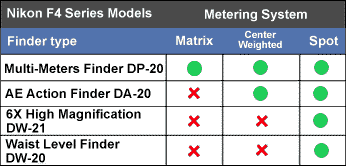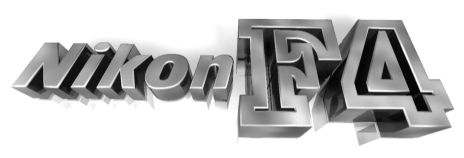Note: This image is almost scaled to an actual dimension of the Nikon F4 on the screen (1024 x 768)The NIkon F4 retains the modular design concept of the F-series. It permits interchangeable prisms to be mounted individually for specific photographic needs. While all other competing brands have dropped this feature on their flagship model(s), Nikon remains as the sole 35 mm SLR manufacturer that still offers this flexible and versatile option in a system camera. If you have been observing the changes in design, in particular functions of the interchangeable prism adopted for the various generations of Nikon professional F-series models, it breaks down as follows: Nikon F / Nikon F2 series - non metered eye level, waist level, 6X magnification and other metered prisms. The Nikon F3 uses a different design as its metering cell is installed inside the camera body and the single-multi task SPD cell eliminates any need for the use of an external metered finder. There is no metered prism available for the Nikon F3 except in the case of the Nikon F3AF with AF and/or electronic range finder (depends on lens types). Both Nikon F4 and Nikon F5 split the metering cell(s) BOTH inside the camera body as well as on the prism which resulted in certain metering only available with the matched prism(s) in use.
Selection of the metering system cannot be easier, there is a dial located at the side of the DP-20 for you to switch to your desired metering pattern. There are a total of four viewfinders designed specifically for the Nikon F4. Other than the standard multi-metered DP-20, an action finder DA-20, 6X high magnification and a waist level finder are available as optional accessory. Interchangeable Finders In addition to the standard Multi-Meter Finder DP-20, the Nikon F4(s) accepts three other interchangeable viewfinders. The chart below shows the combination of viewfinders and metering systems operative.

Despite the plethora of picture taking information made available with the use of the many finder types. The one significant achievement of the Nikon F4 is its ability to retain a 100% picture field coverage. Next, the role of a prism in the F-series was not just confined to an accessory as in the case with the various finders designed for the Nikon F3. As the standard eyelevel finder for the F4 the DP-20 offers a multitask of functions such as diopters adjustments, TTL flash control, focus screen exposure compensation, view finder illumination and the most important of them all - the control of TWO of the three metering systems in the NIkon F4 camera.
The two illumination windows are designed for the purpose of aiding photographer with a clearer view of the LCD displays inside the finder when one operates the camera in ambient light (when you need to illuminate the finder in dim light, just switch on the Finder Illumination Switch located at the base section of the shutter speed ring). Basically, Nikon F5 with DP-30 Multi-meter finder's display system differs from the F4 as it only has an ADR and a full length LCD panel locates at bottom of the picture frame. It also eliminates frame number and exposure compensation value in the separate LCD panel design used in F4 and it is a more straight forward in comparison.
| previous | NEXT | 1/3 The standard finder for Nikon F4 - The Multi-meters DP-20 and its features. How to change finder.
Relative: Prisms for Nikon F Series | Finders Group for Nikon F2 Series | Viewfinders for Nikon F3 Series | Nikon F3AF's DX-1 AF finder
The Camera Body - Features | Reliability | Focusing | Metering | Exposure Control | Lense Compatibility | Interchangeable Prisms | Data Film Backs | Various Power Sources | Focusing Screens | Flash Photography | Other system accessories | Cases for Nikon F4 Series | Remote Control |
| Specification | Main Reference Map | Nikon F4 Variants
Instruction Manual: PDF (4.5M) - External Link| BACK | to Main Index Page Nikon F4 Series Models
| Message Board | for Nikon F4 Series SLR model(s)
| Message Board | for your Nikon Optics in a shared environment
| Message Board | Specifically for Dispose or Looking for Nikon/Nikkor Photographic Equipment| Back | to Pictorial History of Nikon SLR / rangefinders / Nikonos / digital cameras.
Nikon F | Nikon F2 | Nikon F3 | Nikon F4 | Nikon F5 | Nikon F6 | Nikkormat / Nikomat | Nikon FM | Nikon FE/ FA | Nikon EM/FG/FG20 | Nikon Digital SLRs | Nikon - Other models Nikon Auto Focus Nikkor lenses:- Main Index Page
Nikon Manual Focus Nikkor lenses:- Fisheye-Nikkor Lenses - Circular | Full Frame | Ultrawides Lenses - 13mm15mm18mm20mm | Wideangle Lenses - 24mm28mm35mm | Standard Lenses - 45mm 50mm 58mm | Telephoto Lenses - 85mm105mm135mm180mm & 200mm | Super-Telephoto Lenses - 300mm 400mm 500mm 600mm 800mm 1200mm |
Index PageSpecial Application lenses:
Micro-Nikkor Lenses - 50mm~55mm -60mm 85mm -105mm 200mm Micro-Zoom 70-180mm
Perspective Control (PC) - 28mm 35mm PC-Micro 85mm
Dedicated Lenses for Nikon F3AF: AF 80mm f/2.8 | AF 200mm f/3.5 EDIF
Depth of Field Control (DC): 105mm 135mm
Medical Nikkor: 120mm 200mm
Reflex-Nikkor Lenses - 500mm 1000mm 2000mm
Others: Noct Nikkor | OP-Nikkor | UV Nikkor 55mm 105mm | Focusing Units | Bellows-Nikkor 105mm 135mm
Nikon Series E Lenses: 28mm35mm50mm100mm135mm | E-Series Zoom lenses: 36~72mm75~150mm70~210mm
MF Zoom-Nikkor Lenses: 25~50mm | 28~45mm | 28~50mm | 28~85mm | 35~70mm | 36~72mm E | 35~85mm | 35~105mm | 35~135mm | 35~200mm | 43~86mm | 50~135mm | 50~300mm | 70~210mm E | 75~150mm E | 80~200mm | 85~250mm | 100~300mm | 180~600mm | 200~400mm | 200~600mm | 360~1200mm | 1200~1700mm
Tele-Converters: TC-1 | TC-2 | TC-200 | TC-201 | TC-300 | TC-301 | TC-14 | TC-14A | TC-14B | TC-14C | TC-14E | TC-16 | TC-16A | TC-20ERecommended links to understand more technical details related to the Nikkor F-mount and production Serial Number:
http://rick_oleson.tripod.com/index-153.html by: my friend, Rick Oleson
http://www.zi.ku.dk/personal/lhhansen/photo/fmount.htm by: Hansen, Lars Holst
http://www.mir.com.my/rb/photography/hardwares/nikonfmount/lens2.htm
http://www.photosynthesis.co.nz/nikon/serialno.htmlW A R N I N G: The New G-SERIES Nikkor lenses have no aperture ring on the lense, they cannot adjust aperture(s) when operating in manual exposure control even with certain earlier AF Nikon SLR camera models. Similarly, not ALL features provide in a modern AF-S series AF-Nikkor lenses can be utilized fully with a Nikon F4. Please refer to your local distributor for compatibility issue(s).
PLEASE NOTE: Complimentary links are appreciative but it is not necessary, I have limited bandwidth here in this server... So, PLEASE don't distribute this URL to any bulk mailing list or unrelated user-groups, just be a little considerate, thank you. (The more you distribute, the slower this server will response to your requests...). I am NOT a Nikon nor Nikkor expert, so don't send me any mails, use the Message Board Instead. While the content prepared herein should be adequate for anyone to understand and evaluate whether you should invest into a used Nikon F4 pro-camera system for your kind of photography. Well, IF you like what you have seen so far, please help to perfect this site by reporting any broken links or any errors made.

About this photographic site.
Credit: Chuck Hester, US for his patience, encouragement and help to setup the various content in this site; Robert Johnson for some of his original images on the F2H-MD appeared in this site; my ex-staff, KiaSu for his superb 3-D logo appeared in this Nikon F2 site; Marc Vorgers from Holland who generously provide me with some of his images of F2AS; MCLau®, who has so much time with me to re-edit the content in this site and not to mention buying a Nikon Coolpix 990 just for this site; Paul Armstrong (pkared@ameritech.net) for his explantion of the FF2 Slidemagic and Nikon F2 Pin Camera Keat Photo, Kuala Lumpur for providing their Nikon F2A to take some images for this site; Mr Edward Ngoh the great camera collector who provides us his collection of F2AS with MD-2; hawkeye.photographic.com for their images on the Speed Magny film backs; Sean Cranor for his image on Nikon F2 25th Anniversary Model; Ted Wengelaar®, Holland for his continuous flow of input on some of the early Nikon bodies; Genesis-Camera for granting permission to use an image of the SS-F2 camera; Mr Sover Wong, Australia for those great images of his rare F2 Gold;CYLeow ®, photo editor of the Star newspaper, Malaysia for some of his images used in this site. Ms Rissa Chan, Sales manager from Shriro Malaysia who has helped to provide some of the very useful input. HiuraShinsaku®, Nikomat ML, Japan for some of his images on various F2 models; my staff, Wati, Maisa, Mai and my nephew, EEWyn®, who volunteered and helping me did so many of the film scanning works; Hong-sien Kwee of Singapore for all the Nikon F2 Pin camera images appeared in this site; Luigi Crescenzi for many of his images on the Nikon F2 Titan; John for two of his images of the Nikon F2/T used in this site; Contributing photographers or resellers: Jen Siow, Foo KokKin, Arthur Teng, Mark Fallander, John Ishii, Ed Hassel, YoonKi Kim, Jean-Louis, M.Dugentas (Dell Corner.com.), Mr "Arsenall", Yang Zi Xiong and a few images mailed in from surfers with no appropriate reference to their origin. Note:certain content and images appeared in this site were either scanned from official marketing leaflets, brochures published by Nikon and/or contribution from surfers who claimed originality of their own work to publish in this site based on educational merits. The creator of this site will not be responsible for any discrepancies that may arise from such possible dispute except rectifying them after verification."Nikon", "Nikkormat", "Nippon Kokagu KK" & "Nikkor" are registered tradename of Nikon Corporation Inc., Japan. Dedicated to KU Yeo, just to express our mutual regrets over the outcome of a recent corporate event. Made with an Apple IMac.